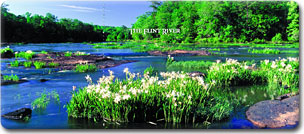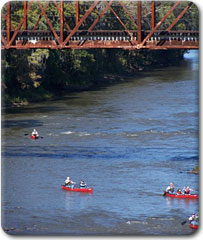Flint River in Georgia
Georgia's Flint River is a beautiful river in western Georgia that gets its name from the Flint stones found along the river's shores.
The Flint River Ga. originates near Atlanta, Georgia, at the base of Atlanta's Hartsfield International Airport and passes through Lake Blackshear (near Cordele, Georgia and home of Georgia Veterans State Park) and Lake Chehaw
 (near Albany, Georgia) before converging with the Chattahoochee River at the Jim Woodruff Lock and Dam where the rivers merge to create Lake Seminole.
(near Albany, Georgia) before converging with the Chattahoochee River at the Jim Woodruff Lock and Dam where the rivers merge to create Lake Seminole.
The single river that leaves Lake Seminole is known as the Apalachicola, which flows through Florida to the Gulf of Mexico. Along with the Apalachicola and the Chattahoochee, the more than 200-mile-long Flint River forms part of the ACF basin (Apalachicola, Chattahoochee, and Flint Rivers).
Between the Flint River's urban beginning and its reservoir ending, its watershed drains some 8,460 square miles and encompasses the cities of Jonesboro, Thomaston, Montezuma, Marshallville, Cordele, Americus, Albany, and Bainbridge. This watershed can be divided into three distinct regions, the Upper, Middle, and Lower Flint, based on landscape, channel characteristics, flora, and fauna, according to The New Georgia Encyclopedia.
Among many notable landmarks within the Flint River watershed is the Flint River Technical College in Thomaston, Georgia, which isn't actually on the Flint River but is near Sprewell Bluff State Park, which the Flint River runs through.
"From its humble beginning at the base of the world's busiest airport, the Flint River quickly transforms into one of the most beautiful wild and scenic riverine environments in Georgia," describes the Sherpa Guides. "The Flint River continues to flow freely through one of the most naturally beautiful and ecologically diverse sections of Georgia."
 "The natural history of the river includes catastrophic floods that have submerged the floodplain and its inhabitants, and extreme droughts that have reduced the river to a fraction of its normal flow. Through it all, the impressive diversity and beauty of plant and animal life that are characteristic of the entire Flint River system have remained."
"The natural history of the river includes catastrophic floods that have submerged the floodplain and its inhabitants, and extreme droughts that have reduced the river to a fraction of its normal flow. Through it all, the impressive diversity and beauty of plant and animal life that are characteristic of the entire Flint River system have remained."
Ironically (given its history of floods), it's been Georgia's severe drought in recent years that has posed one of the largest threats to the Flint River, especially the Lower Flint, due to its shallow aquifer discharge.
But the river remains a vital piece to Georgia, both for its delicate ecosystems and value as a water source. In October 2009, American Rivers declared the Flint River to be on the most endangered rivers in the country, mainly due to plans to put a dam on it, according to Wikipedia.
The Flint River Georgia is also a rich resource for tourism and leisure. Its most prominent tourist attraction is in the city of Albany, which opened the Flint RiverQuarium in September 2004. The Flint River Quarium is an aquarium that features a 175,000-gallon, 22-foot-deep, "blue hole" filled with the flora and fauna found in the Flint River's ecosystem.
Another Flint River recreational attraction is the Flint River Outdoor Center in Thomaston, Georgia, which offers a lodge and primitive camping for vacationers as well as guided canoeing and fishing trips and river advice for canoeists and kayakers looking to enjoy the Flint River.
More on Georgia's Flint River:
»
Sherpa Guides - The Flint River
»
Georgia Wildlife Federation - Flint River
»
The New Georgia Encyclopedia - Flint River
»
Flint River Conservation Association
»
Flint River Technical College
»
Wikipedia - Flint River (Georgia)